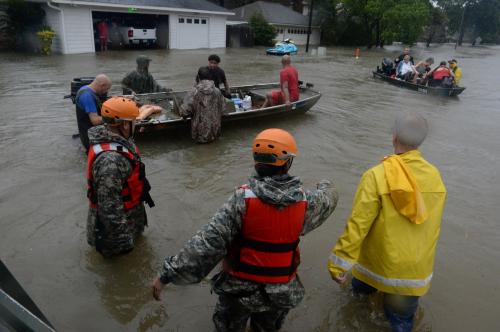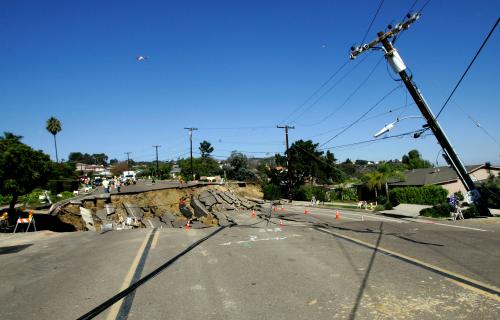The 2017 Atlantic hurricane season is not over yet, but it has already brought some of the most catastrophic storms in recent memory. In the same way that Hurricane Katrina reshaped New Orleans, the destruction wrought by Harvey, Irma, and Maria will have lasting consequences for cities in Texas, Florida, and Puerto Rico. The devastation is likely to be even more long-lasting for many of the hardest hit small islands in the Caribbean.
In any season with multiple catastrophes, there is always tremendous strain on federal and international disaster response resources. Governments have always been ‘insurers of last resort.’ However, with the increasing frequency and severity of disasters, governments at all levels—cities, states, federal agencies, and international aid agencies—are being put in the position of insurers of first resort. This is completely unsustainable.
The U.S. National Flood Insurance Program (NFIP) is already almost $25 billion in debt. After Hurricanes Harvey and Irma, the program is likely to hit its borrowing cap of $30.4 billon.
Solving the problem by raising borrowing limits is only a temporary fix to a chronic and worsening problem.
So how can governments at all levels take a different approach to managing natural disasters?
In a new report, A Guide to Public-Sector Resilience Bond Sponsorship, my co-author James Rhodes and I highlight how Resilience Bonds can help local, state, and federal government agencies and international development banks make the leap from disaster relief to resilience. Resilience Bonds are a variation on standard catastrophe bonds that connect financial protections in the form of catastrophe insurance with investments in on-the-ground risk reduction projects, like seawalls or building retrofits.
The benefits of connecting disaster risk reduction with existing insurance programs are well proven in the insurance industry. Insurers regularly support “loss mitigation” activities within their portfolios to reduce the likelihood of major insurance claims. Lower risks can also be priced into these insurance policies to reduce premiums. The same is not true in the public sector. Public sector risk reduction projects, by virtue of being public, generally have diffuse benefits covering large populations with varying levels of private insurance uptake.
Consider major infrastructure projects, like Seattle’s new multi-billion dollar seawall, or broad environmental mandates, like statewide stormwater management regulations that implicitly incentivize flood risk reduction. The value of these protections rarely translate neatly into financial models or existing insurance portfolios. In the absence of near-term revenues, these types of projects can be exceptionally difficult to fund or finance. They can take years to plan and be dogged by uncertain funding and shifting timelines. The result is a combination of market failures that makes it hard to capture insurance savings even when the projects provide significant long-term benefits. Resilience Bonds offer visibility and control over risk reduction projects for public officials, providing a new way to leverage private capital and speed along the design, funding, and implementation of high-priority projects.
Making this link between short-term disaster risk reduction and long-term resilience can help local leaders make major investments to protect their communities. Miami-Dade County is a great example: the Department of Water & Sewer plans to spend $13 billion on comprehensive system upgrades over the next two decades and is prioritizing essential resilience projects as part of its Capital Improvement Plan. Coastal cities around the world are facing existential decisions about how to manage rising waters and more severe storms. Miami-Dade’s local officials need to be applauded for their leadership and example, and all cities and utilities should be encouraged to take the next step: capture the insurance benefits of resilience projects to create a virtuous cycle of further improvements. Without that step, reliance on government disaster relief funds will inevitably grow.
In order to leverage private finance for the kinds of public-sector resilience projects that Miami-Dade is pushing forward, government officials must have access to reliable technical assistance to ensure that the terms of any transaction are in the public interest. The Government of Mexico has benefitted from exactly this type of honest broker service from the World Bank. The Mexican national disaster management agency (FONDEN) issued its first catastrophe bond in 2006 with the support and backing of the World Bank. Since then, it has reissued and expanded its bond coverage several times. Proof that this program is working is in the $50 million USD payout the government received after Hurricane Patricia in 2015 and the likelihood of another payout after the country’s recent 8.1 magnitude earthquake.
With global support for new insurance partnerships from the United Nations and the G20, it is increasingly important to ensure that public interest is protected. This requires new types of honest brokers who can offer trusted guidance (similar to municipal bond counsels). As the public-private partnership industry has demonstrated, there is great potential for success, but there is also plenty of room for mischief. The job of private insurers is to make money, and it falls on governments to get good advice and limit contracting risks. Our report includes a flowchart decision-guide that identifies where trusted transaction support for new Resilience Bonds can help governments around the world break the cycle of making major budget decisions on a disaster-by-disaster basis.
Private insurance, of course, is not a substitute for all public disaster resources. Government agencies will always have an important backstop role to play as insurers of last resort. What is clear after this hurricane season, though, is that government funds cannot be the first choice after every catastrophe.







Commentary
Making the leap from disaster relief to resilience
October 4, 2017